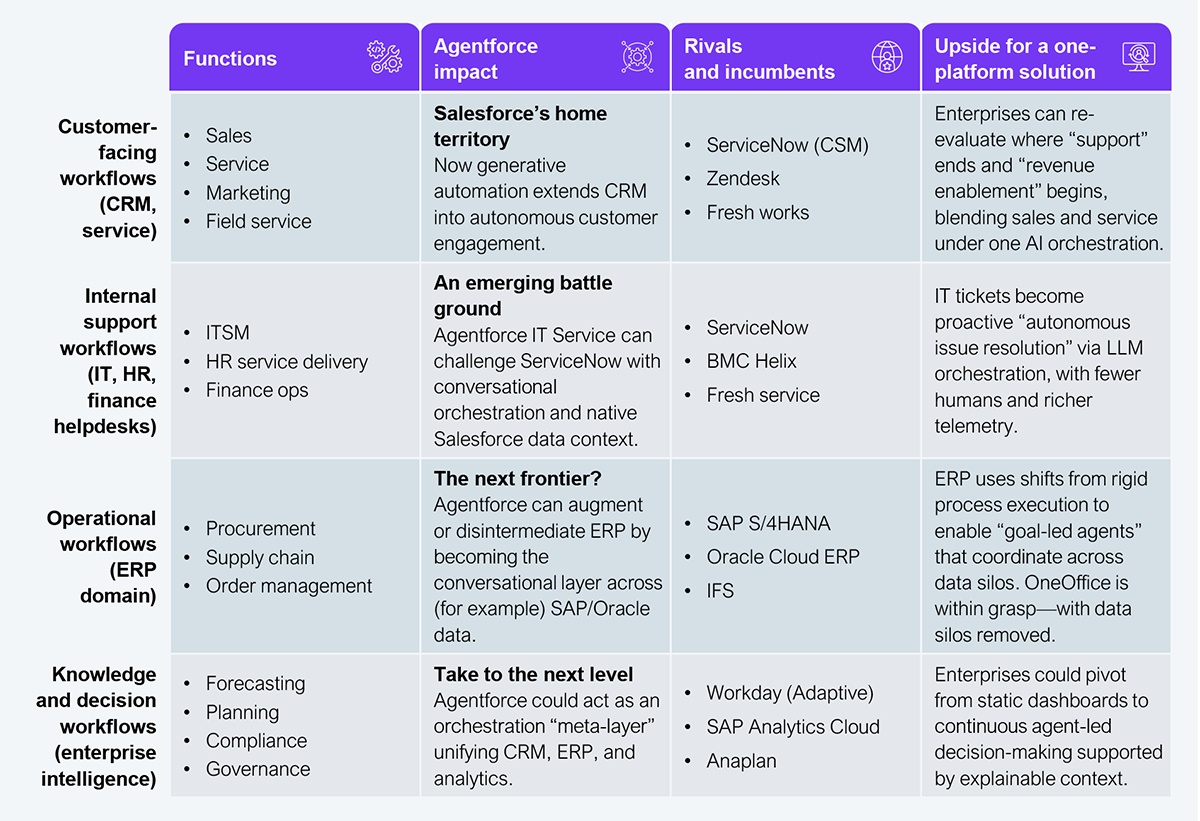Enterprises must scale the value they get from agentic artificial intelligence (AI) solutions by embedding agentic AI in core operations. Failure to do so will leave them stuck in test-and-learn trials and one-off process efficiency drives.
That realization is behind Salesforce’s wholesale pivot to Agentforce, as demonstrated in a series of well-designed use cases for operations teams embedded in updates to products shared at Dreamforce 2025. The shift goes beyond Sales and Service Clouds, representing a break from the firm’s customer relationship management (CRM) and front-office roots. This is a pitch to become the agentic solution for operations teams in industries and back offices, under the “agentic enterprise” banner.
Salesforce now offers the integration of enterprise signals gathered in Data 360 (formerly Data Cloud), ready-made to provide context for relevant and controlled actions across systems, in Agentforce 360. Potential upsides from such a one-platform integrated solution include (see Exhibit 1) blended sales and services, richer telemetry in IT service ticket resolution, new opportunities to update processes by coordinating data across enterprise resource planning (ERP) silos, and potentially a unified meta-layer pulling together CRM and ERP and analytics to improve forecasting and planning.

Source: HFS Research, 2025
Examples such as Dell’s Agentforce supply chain demo, made possible by Salesforce’s recent acquisition of Regrello, reimagine traditional supplier relationship management through agentic workflows, providing an operational “how” story. The example demonstrates that Agentforce can power a shift from legacy processes (reaching 19,000 suppliers manually) to automated, agent-mediated flows.
Finance and human resources (HR) workflow agents can automate routine back-office tasks such as invoice matching, approvals, and HR onboarding, too. An AI agent built on Agentforce 360 can monitor finance data fed by Data 360, detect missing invoices, notify stakeholders, initiate approvals, and update statuses in ERP and CRM.
At Dreamforce, Salesforce turned the spotlight on vertical use cases, too, with examples in manufacturing, retail, and financial services. In retail, Dreamforce presented the example of Williams-Sonoma, where customers can now use an agent to find recipes based on their own natural-language descriptions of any meal they’d like to plan—whether a fall family feast or a spring party—and receive tutorials linked to products they purchase. That goes beyond simple customer experience to operational fulfillment, with the opportunity to better align supply and demand.
Agentic operations have arrived: a new category where finance, operations, supply chain, and HR agents are among those jostling for ops leaders’ attention amid a changing ecosystem of vendors in which Salesforce is positioning itself. Salesforce’s install base is huge, but while the uptake of Agentforce has been “faster” than any previous Salesforce product (according to CEO Marc Benioff), the numbers are still relatively low, with 12,500 customers, representing 8% of the 150,000-strong customer base.
Agentforce’s late 2025 updates make for a brave and wide-ranging land-grab for agentic operations at a time when enterprises must shift from AI experiments to AI expectations. One-platform solutions do offer a fast track to a trustworthy enterprise context—the power behind effective enterprise-grade agents.
This is going to be a highly competitive space, so be wary of over-committing too early to any particular platform. Seek partners that align with your own business vision first to avoid being seduced by the grandiose visions some vendors may wish to sell you.
Register now for immediate access of HFS' research, data and forward looking trends.
Get StartedIf you don't have an account, Register here |
Register now for immediate access of HFS' research, data and forward looking trends.
Get Started